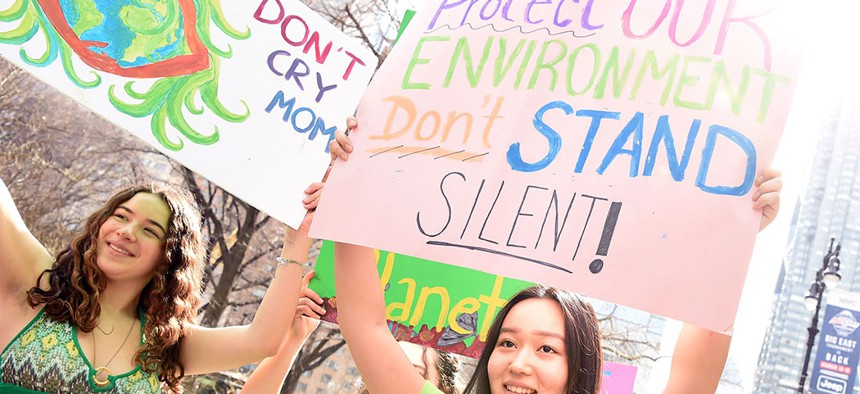New York State
NY lawmakers near deal on climate change
The state Legislature and Gov. Andrew Cuomo are on the brink of finalizing a deal on landmark climate change legislation that aims to effectively eliminate climate change pollution statewide by 2050. Here’s how the updated bill compares to the original version.

Students protesting during the New York City march for action on climate change in March. Stephen Lovekin/Shutterstock
The state Legislature and Gov. Andrew Cuomo are on the brink of finalizing a deal on landmark climate change legislation that aims to effectively eliminate climate change pollution statewide by 2050.
The forthcoming deal – confirmed by Cuomo in a Monday morning radio appearance on WAMC – includes significant changes to a previous version of the Climate and Community Protection Act. This includes a provision requiring a slower transition to renewable energy by 2030 and changes that gives the Legislature more influence over a proposed “Climate Action Council.” A new version of the bill was submitted State Sen. Todd Kaminsky on Sunday night, giving lawmakers just enough time to pass the bill before the end of session on Wednesday, after the required three-day waiting period for new legislation. A final deal on the bill, which appeared elusive just a few days ago, could be announced as soon as Monday.
However, additional changes are likely. If that happens, then Cuomo would have to issue a legislative message of necessity suspending the three-day requirement, or lawmakers could pass the current bill, which could be altered later through a chapter amendment. State Sen. Todd Kaminsky and Assemblyman Steven Englebright, the primary sponsors of the legislation, could not be reached for comment by press time.
Despite reports of an impending agreement, advocates said they would continue to press lawmakers to pass the legislation, which would codify climate change goals into state law. The amended bill included some provisions that were less than what activists wanted, but New York Renews – a coalition of more than 180 organizations backing the CCPA – is getting behind the final deal, according to Katherine Nadeau, deputy director of Catskill Mountainkeeper. “While we didn’t get everything we were hoping for, this, at the end of the day, is a major victory,” she said. “This marks the beginning, not the end, of major climate action in New York state.”
Here’s how the updated bill compares to the version submitted earlier this year:
Slower pace of reducing greenhouse gas emissions
The bill still aims to eliminate all anthropogenic sources of greenhouse gas emissions by 2050. The original bill aimed for a 50% reduction in climate pollution, based on 1990 levels, by the year 2030. That latest version changes that to 40% by 2030.
Faster transition to renewable energy
The original version of the bill aimed to have New York produce 50% of its electricity from renewable sources by 2030. That has now changed in the latest version to 70% renewable electricity by 2030. Both versions called to make electricity 100% renewable by 2040.
Expanded definition of “disadvantaged communities”
An important facet of the CCPA is how it would direct funding to communities affected by climate change. The latest version of the bill includes a tweak that adds a new clause to the definition of “disadvantaged communities” to mean “communities that bear burdens of negative public health effects, environmental pollution impacts of climate change, and possess certain socioeconomic criteria or comprise high-concentrations of low-and moderate income households.”
Slightly less funding for “disadvantaged communities”
A key part of the CCPA is the emphasis it places on “environmental justice” – the idea that low-income communities and communities of color are bearing the brunt of some of the worst effects of climate change. That is why the original bill included a provision that required 40% of any future funds from taxes on carbon dioxide emissions and other funding be directed at these communities. The latest version keeps the 40% standard as a goal but now states that 35% is the minimum, while expanding the definition of “disadvantaged communities” to one that could incorporate more middle-income and majority-white communities.
Power over proposed climate action council shifting from governor to Legislature
The amended bill includes several changes to a proposed climate action council that would help the state determine how to implement the law. This includes making the president of the New York State Energy Research and Development Agency – currently Alicia Barton – co-chair of the council alongside the commissioner of the state Department of Environmental Conservation. The new bill also curtails the influence of the DEC and the governor over the council in other ways. The leaders of the state Senate and Assembly will get three appointments each to the 22-member council, compared to two each before. There is also a new requirement that two of the gubernatorial appointees be from outside state agencies, and the council will have more influence over the development of a final scoping plan, according to the amended bill.
More wiggle room in completely eliminating greenhouse gas emissions
The new bill allows for 15% of the state’s greenhouse gas emissions to be offset by carbon reduction strategies, such as planting more trees or carbon sequestration technology. Advocates had been pushing for a 100% reduction but there had been concerns that would be too difficult a task, especially considering that eliminating emissions in some economic sectors – like manufacturing, where they can be caused by chemical processes – is more difficult than in others.
NEXT STORY: Saini leaves DoITT amidst controversy

